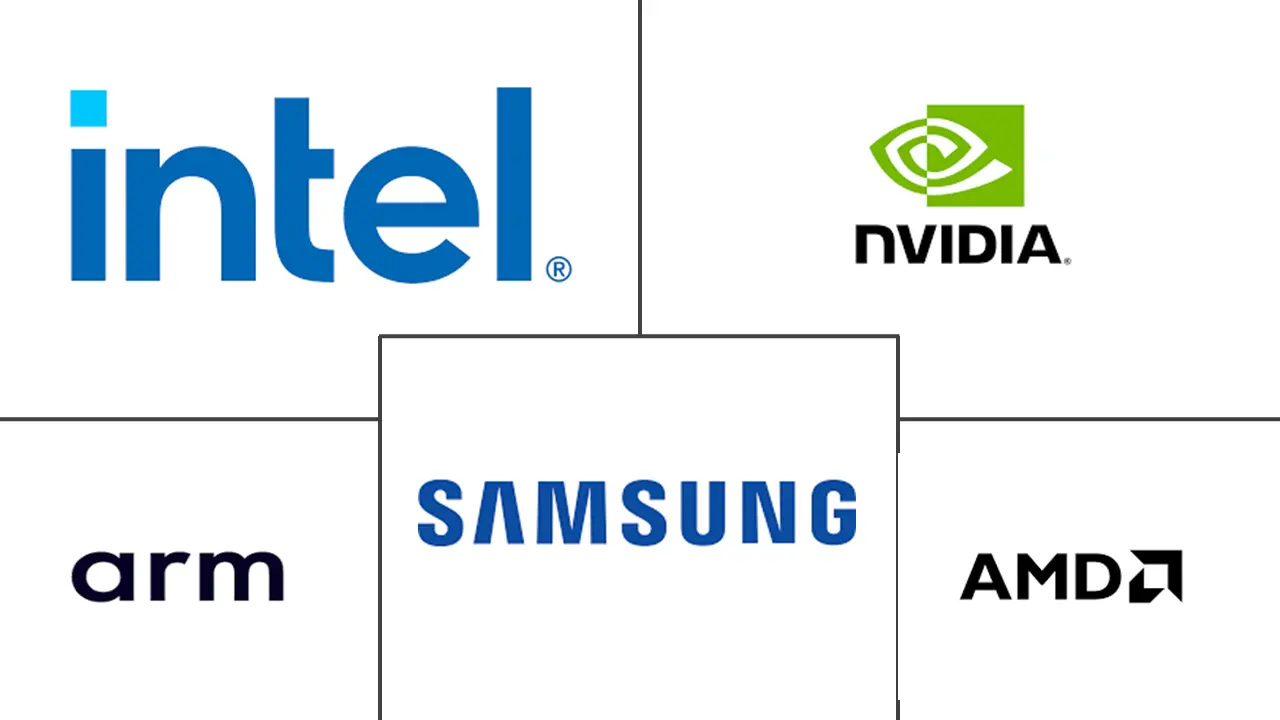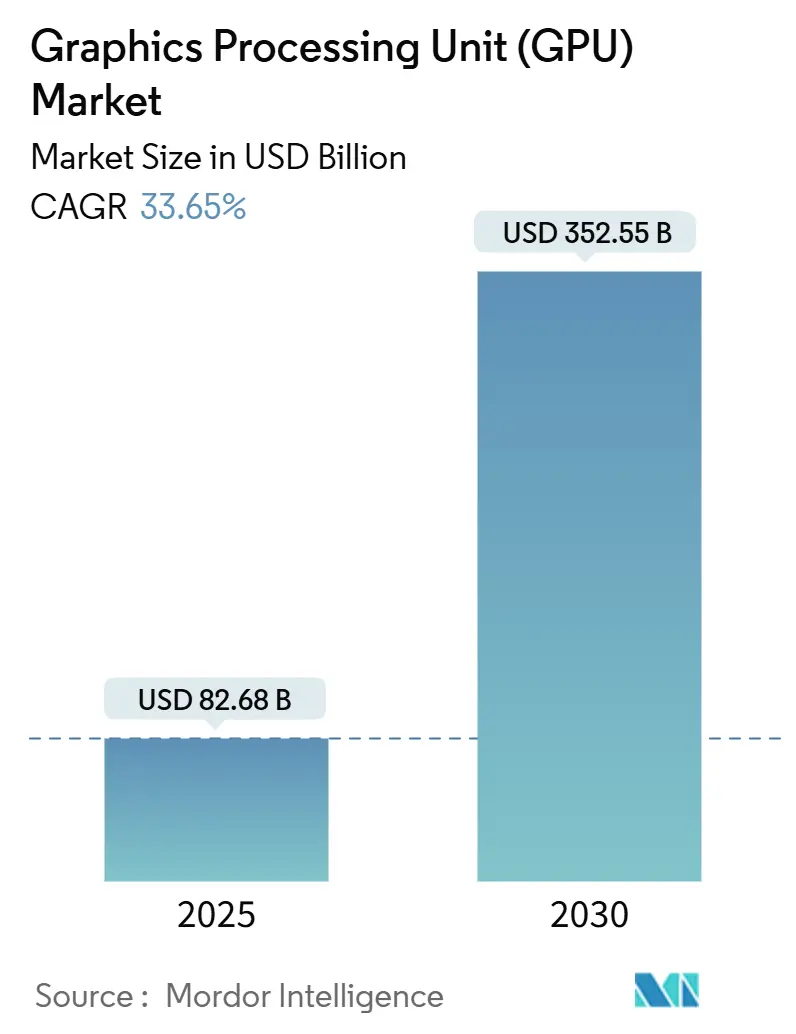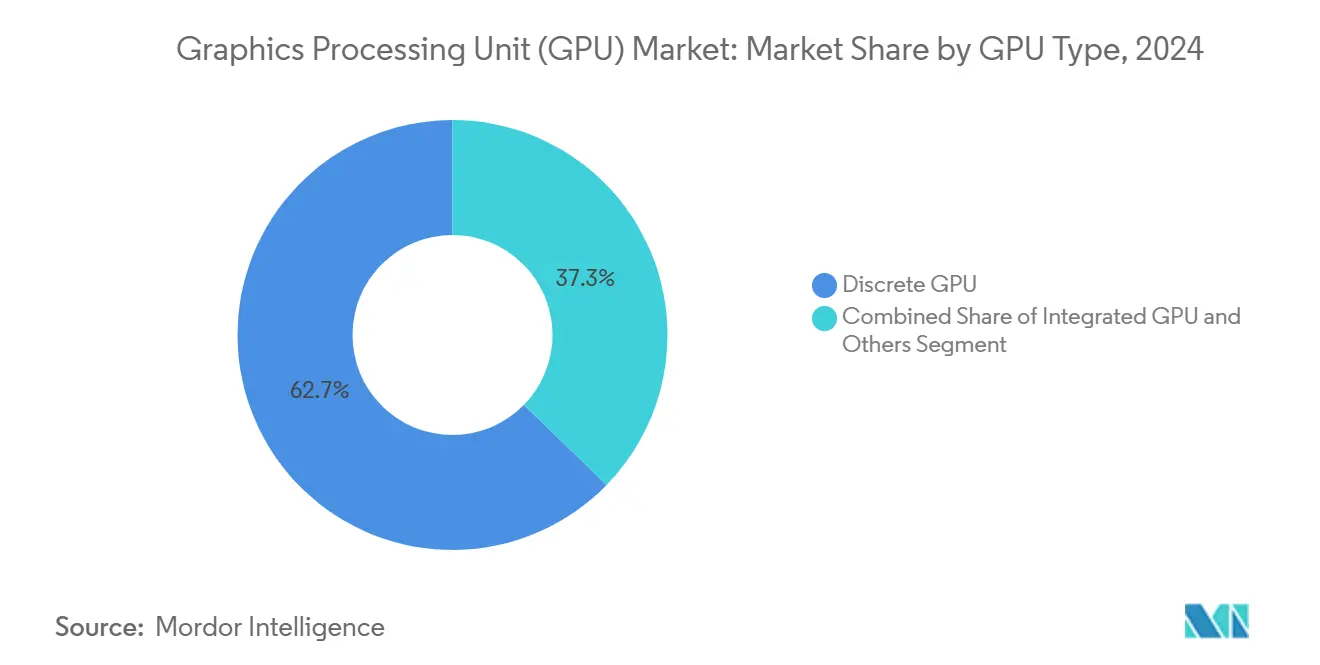Graphics Processing Unit (GPU) Market Size and Share
Graphics Processing Unit (GPU) Market Analysis by Mordor Intelligence
The graphics processing unit market size stands at USD 82.68 billion in 2025 and is forecast to reach USD 352.55 billion by 2030, delivering a 33.65% CAGR. The surge reflects an industry pivot from graphics-only workloads to AI-centric compute, where GPUs function as the workhorses behind generative AI training, hyperscale inference, cloud gaming, and heterogeneous edge systems. Accelerated sovereign AI initiatives, corporate investment in domain-specific models, and the rapid maturation of 8K, ray-traced gaming continue to deepen demand for high-bandwidth devices. Tight advanced-node capacity, coupled with export-control complexity, is funneling orders toward multi-foundry supply strategies. Meanwhile, chiplet-based designs and open instruction sets are introducing new competitive vectors without dislodging the field’s current concentration.
Key Report Takeaways
- By GPU type, discrete boards held 62.7% of graphics processing unit market share in 2024 and are growing at a 32.7% CAGR through 2030.
- By device application, PCs and Workstations held 31.4% of market share in 2024, while servers and data-center accelerators logged the fastest 37.6% CAGR.
- By deployment model, on-premise solutions accounted for 56.5% share of the graphics processing unit market size in 2024, yet cloud workloads are expanding at 35.3% CAGR.
- By Instruction-Set Architecture, x86-64 accounted for 54.3% share of the graphics processing unit market size in 2024, yet RISC-V and OpenGPU are expanding at 34.8% CAGR.
- By geography, Asia-Pacific is advancing at 37.4% CAGR, outpacing North America’s current 43.7% revenue share.
Global Graphics Processing Unit (GPU) Market Trends and Insights
Drivers Impact Analysis
| Driver | (~) % Impact on CAGR Forecast | Geographic Relevance | Impact Timeline |
|---|---|---|---|
| Evolving graphics realism in AAA gaming | + 4.2% | Global, with concentration in North America and Europe | Medium term (2-4 years) |
| AR/VR and AI-led heterogeneous computing demand | + 6.8% | North America and Asia-Pacific core, spill-over to Europe | Long term (≥ 4 years) |
| Cloud-gaming service roll-outs | + 3.5% | Global, early adoption in North America and Europe | Short term (≤ 2 years) |
| Generative-AI model training GPU intensity | + 12.4% | Global, concentrated in North America and Asia-Pacific | Short term (≤ 2 years) |
| "Sovereign-AI" datacenter build-outs | + 8.9% | Asia-Pacific core, Europe, Middle East expansion | Medium term (2-4 years) |
| Chiplet-based custom GPU SKUs | + 2.7% | Global, led by North America technology centers | Long term (≥ 4 years) |
Source: Mordor Intelligence
Generative-AI Model Training GPU Intensity
Large-parameter transformer models routinely exceed 100 billion parameters, forcing enterprises to operate tens of thousands of GPUs in parallel for months-long training runs, elevating tensor throughput above traditional graphics metrics.[1]NVIDIA Corporation, “NVIDIA Announces Financial Results for First Quarter Fiscal 2026,” nvidia.com High-bandwidth memory, lossless interconnects, and liquid-cooling racks have become standard purchase criteria. Healthcare, finance, and manufacturing firms now mirror hyperscalers by provisioning dedicated super-clusters for domain models, a pattern that broadens the graphics processing unit market’s end-user base. Mixture-of-experts architectures amplify the demand, as workflows orchestrate heterogeneous GPU pools to handle context-specific shards. Power-density constraints inside legacy data halls further accelerate migration to purpose-built AI pods.
Sovereign-AI” Datacenter Build-outs
Governments view domestic AI compute as a strategic asset akin to energy or telecom backbone. Canada allocated USD 2 billion for a national AI compute strategy focused on GPU-powered supercomputers.[2]Innovation, Science and Economic Development Canada, “Canadian Sovereign AI Compute Strategy,” ised-isde.canada.caIndia’s IndiaAI Mission plans 10,000+ GPUs for indigenous language models. South Korea is stockpiling similar volumes to secure research parity. Such projects convert public budgets into multi-year purchase schedules, stabilizing baseline demand across the graphics processing unit market. Region-specific model training—ranging from industrial automation in the EU to energy analytics in the Gulf—expands architectural requirements beyond datacenter SKUs into ruggedized edge accelerators.
AR/VR and AI-Led Heterogeneous Computing Demand
Modern head-mounted displays must render dual 4K lenses at 90+ FPS while executing computer-vision inference for hand-tracking and spatial mapping. GPUs, therefore, integrate dedicated tensor cores to offload AI tasks without disrupting frame delivery nvidia.com. Enterprise simulations, medical holography, and digital-twin engineering further demand workstation-class boards. Automotive advanced driver assistance systems bring the same heterogeneous workload mix into fanless edge form factors, keeping real-time latency below safety thresholds. As AI compounds graphics loads, architectural roadmaps now prioritize shared cache hierarchies and chiplet IO to co-optimize rendering and learning.
Cloud-Gaming Service Roll-outs
Streaming game platforms rely on server-grade GPUs equipped with hardware video encoders and AI-powered upscaling to maintain responsive visuals over constrained bandwidth. Each active user consumes orders of magnitude more compute than text-based cloud software, multiplying graphics processing unit market demand per data-center rack. Global footprint expansion obliges service providers to deploy regional edge nodes, drawing incremental orders for compact, high-density GPU sleds. As 8K and 120 FPS targets loom, next-generation silicon budgets allocate proportionally larger die area to media engines and tensor logic to compress frames efficiently.
Restraints Impact Analysis
| Restraint | (~) % Impact on CAGR Forecast | Geographic Relevance | Impact Timeline |
|---|---|---|---|
| High upfront capex and BOM costs | -3.8% | Global, particularly affecting emerging markets | Short term (≤ 2 years) |
| Chronic advanced-node supply constraints | -5.2% | Global, concentrated impact on leading-edge products | Medium term (2-4 years) |
| Export-control limits on ≤7 nm GPU sales | -4.6% | China-focused, secondary effects on global supply | Short term (≤ 2 years) |
| Cooling / power-density limits in hyperscale DCs | -2.9% | Global, acute in high-density AI deployments | Medium term (2-4 years) |
Source: Mordor Intelligence
Export-Control Limits on ≤ 7 nm GPU Sales
The United States introduced tiered licensing for advanced computing ICs, effectively curbing shipments of state-of-the-art GPUs to China.[3]Olga Torres and Derrick Kyle, “Artificial Intelligence Export Controls,” trade.govNVIDIA booked a USD 4.5 billion charge tied to restricted H20 accelerators, illustrating revenue sensitivity to licensing shifts. Chinese firms responded by fast-tracking domestic GPU projects, potentially diluting future demand for U.S. IP. The bifurcated supply chain forces vendors to maintain multiple silicon variants, lifting operating costs and complicating inventory planning throughout the graphics processing unit market.
Chronic Advanced-Node Supply Constraints
Cutting-edge wafer capacity remains highly concentrated, with lead-times extending beyond 18 months for 2-nm and CoWoS packaging slots. Limited substrate availability constrains high-bandwidth memory integration, capping output of AI-centric boards. While additional lines at Samsung and Intel Foundry are under construction, performance parity and yield stability are still trailing the market leader, delaying effective relief. OEMs therefore prioritize allocation to training SKUs, periodically starving consumer channels and elevating average selling prices.
Segment Analysis
By GPU Type: Discrete Solutions Drive AI Acceleration
Discrete boards controlled 62.7% of the graphics processing unit market share in 2024, translating to the largest slice of the graphics processing unit market size for that year. Demand concentrates on high-bandwidth memory, dedicated tensor cores, and scalable interconnects suited for AI clusters. Enterprises favor modularity, enabling phased rack upgrades without motherboard swaps. Gaming continues to validate high-end variants by adopting ray tracing and 8K assets that integrated GPUs cannot sustain.
Chiplet adoption is lowering the cost per performance tier and improving yields by stitching smaller dies. AMD’s multi-chiplet layout and NVIDIA’s NVLink Fusion both extend discrete relevance into semi-custom server designs. Meanwhile, integrated GPUs remain indispensable for mobile and entry desktops where thermal budgets dominate. The graphics processing unit industry thus segments along a mobility-versus-throughput spectrum rather than a pure cost axis.
Note: Segment shares of all individual segments available upon report purchase
By Device Application: Data Centers Accelerate AI Infrastructure
Servers and data-center accelerators are projected to register the fastest 37.6% CAGR through 2030, underpinning the swelling graphics processing unit market. Hyperscale operators provision entire AI factories holding tens of thousands of boards interconnected via optical NVLink or PCIe 6.0 fabrics. Sustained procurement contracts from cloud providers, public research consortia, and pharmaceutical pipelines jointly anchor demand at multi-year horizons.
Gaming systems remain the single largest installed-base category, but their growth curve is modest next to cloud and enterprise AI. Automotive, industrial robotics, and medical imaging represent smaller yet high-margin verticals thanks to functional-safety and long-life support requirements. Collectively, these edge cohorts diversify the graphics processing unit industry’s revenue away from cyclical consumer cycles.
By Deployment Model: Cloud Adoption Transforms Infrastructure
On-premise installations retained a 56.5% share of the graphics processing unit market size in 2024, upheld by data-sovereignty mandates in finance and healthcare. Nonetheless, cloud services are compounding at 35.3% CAGR as enterprises shift from capex to opex for AI workloads. Subscription access to elastic GPU fleets removes the provisioning lag inherent to physical procurement and aids smaller teams entering generative AI experimentation.
Hybrid sovereign-cloud constructs blend national data centers with commercial elasticity. Canada’s public supercomputing backbone lets universities burst into excess capacity, aligning with budget cycles while keeping sensitive datasets in-country. Edge deployments, including cloud-gaming nodes and smart-factory gateways, push GPUs closer to end users to satisfy latency requirements below 20 ms, further broadening deployment diversity inside the graphics processing unit market.
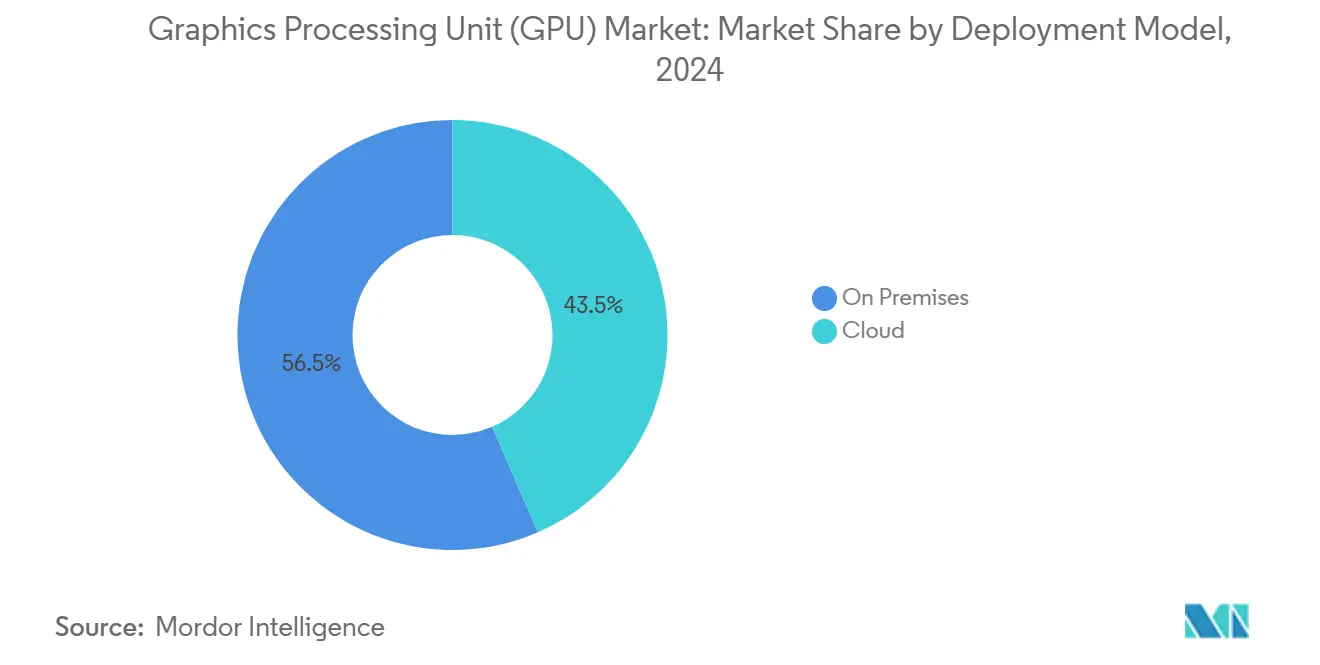
By Instruction-Set Architecture: Open Standards Challenge Proprietary Dominance
x86-64 systems still commanded 54.3% revenue share in 2024. Yet RISC-V and other open architectures are on track for a 34.8% CAGR, reflecting the appetite for royalty-free customization. Academic projects such as Georgia Tech’s Vortex demonstrate OpenCL-capable RISC-V GPUs, lowering barriers for sovereign chip programs. ARM GPUs, meanwhile, dominate smartphones, serving battery-constrained edge AI.
Open ISAs allow governments and startups to hard-code domain extensions—speech, vision, encryption—without negotiating proprietary licenses. This optionality is particularly attractive for nations operating under export-control uncertainty. For incumbents, the rise of open architectures injects new collaboration models, where proprietary CUDA or ROCm stacks must increasingly interoperate with external toolchains to keep their share in the graphics processing unit market.
Geography Analysis
North America captured 43.7% graphics processing unit market share in 2024, anchored by Silicon Valley chip design, hyperscale cloud campuses, and deep venture funding pipelines. The region benefits from tight integration between semiconductor IP owners and AI software start-ups, accelerating time-to-volume for next-gen boards. Export-control regimes do introduce compliance overhead yet simultaneously channel domestic subsidies into advanced-node fabrication and packaging lines.
Asia-Pacific is the fastest-growing territory, expected to post a 37.4% CAGR to 2030. China accelerates indigenous GPU programs under technology-sovereignty mandates, while India’s IndiaAI Mission finances national GPU facilities and statewide language models. South Korea’s 10,000-GPU state compute hub and Japan’s AI disaster-response initiatives extend regional demand beyond commercial clouds into public-sector supercomputing.
Europe balances stringent AI governance with industrial modernization goals. Germany partners with NVIDIA to build an industrial AI cloud targeting automotive and machinery digital twins. France, Italy, and the UK prioritize multilingual LLMs and fintech risk analytics, prompting localized GPU clusters housed in high-efficiency, district-cooled data centers. The Middle East, led by Saudi Arabia and the UAE, is investing heavily in AI factories to diversify economies, further broadening the graphics processing unit market footprint across emerging geographies.
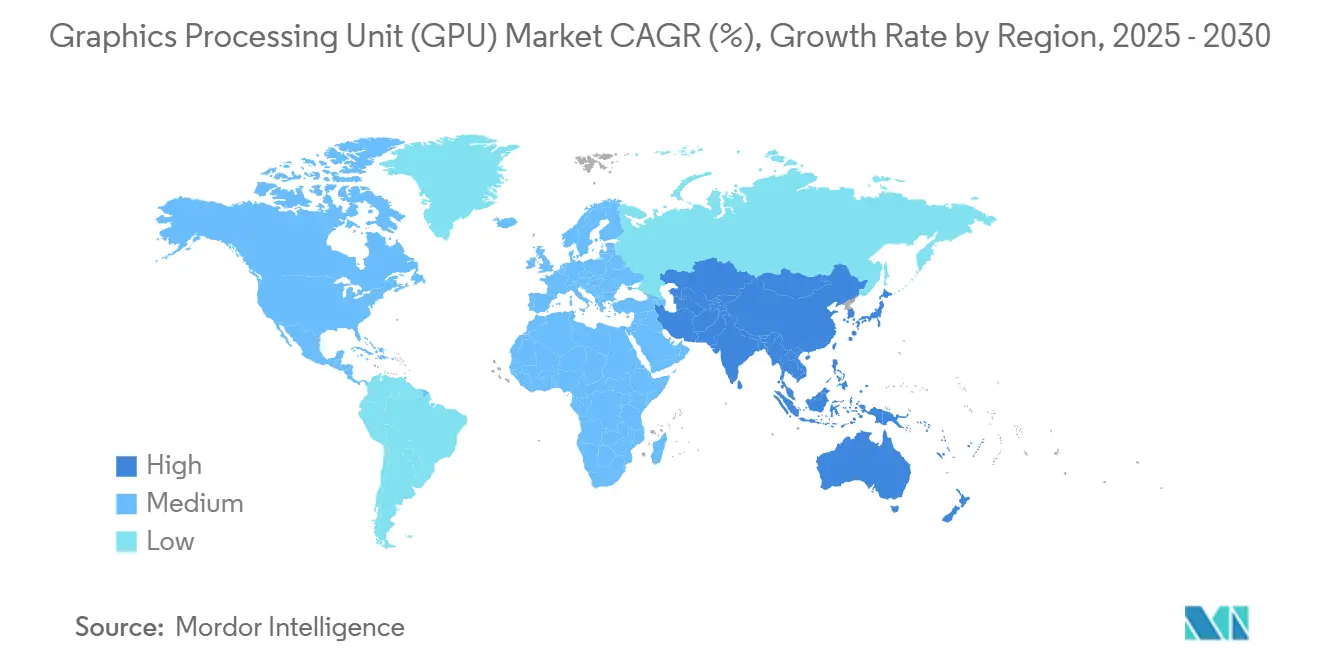
Competitive Landscape
Strategic partnerships define recent maneuvers. NVIDIA and Alphabet expanded collaboration to co-optimize agentic models, placing GB300 NVL72 clusters inside Google Cloud regions. AMD and HUMAIN signed a USD 10 billion deal to stand up 500 MW of AI compute across a multi-country footprint, guaranteeing volume for Instinct accelerators. At the edge, Hyundai Motor Group adopted NVIDIA DRIVE to shorten autonomous-vehicle timelines, illustrating vertical integration trends.
Chiplet-ready roadmaps reshape competitive economics, letting vendors mix reticle-limited graphics dies with custom IO tiles. This modularity invites smaller fabless entrants to license individual tiles rather than build monolithic GPUs, nudging the graphics processing unit industry toward ecosystem competition. Open-source RISC-V efforts further dilute proprietary constraints and could create future equivalent of a “white-box” GPU, especially in government and academic labs.
Export-control granularity has become a competitive tool: firms able to supply compliant sub-7 nm substitutes may backfill restricted demand into China, while also maintaining premium segments in unrestricted markets. Finally, advanced packaging alliances—covering CoWoS, Foveros, and InFO—illustrate how value capture is drifting toward substrate innovation, not just silicon IP, reinforcing broad supplier interdependencies within the graphics processing unit market.
Graphics Processing Unit (GPU) Industry Leaders
-
Intel Corporation
-
Nvidia Corporation
-
Samsung Electronics Co. Ltd
-
Arm Ltd.
-
Advanced Micro Devices Inc.
- *Disclaimer: Major Players sorted in no particular order
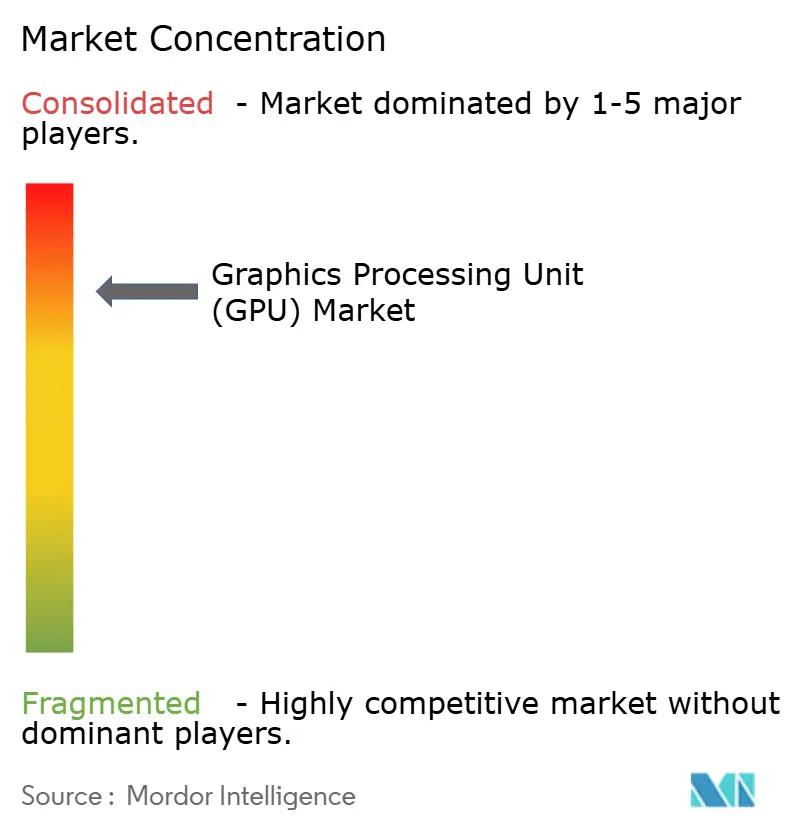
Recent Industry Developments
- June 2025: NVIDIA and Alphabet deepened cooperation on agentic and physical AI; Google Cloud adopted GB300 NVL72 and RTX PRO 6000 Blackwell GPUs for drug-discovery and robotics workloads.
- June 2025: NVIDIA and Deutsche Telekom launched Europe’s first industrial AI cloud in Germany, provisioning 10,000 Blackwell GPUs for manufacturing AI.
- May 2025: AMD and HUMAIN unveiled a USD 10 billion program to deploy 500 MW of AI compute capacity across the United States and Saudi Arabia.
- May 2025: NVIDIA introduced NVLink Fusion, allowing semi-custom AI systems that combine NVIDIA GPUs with partner CPUs.
- May 2025: Hyundai Motor Group signed with NVIDIA to co-develop accelerated computing platforms for future mobility
Global Graphics Processing Unit (GPU) Market Report Scope
A graphics processing unit (GPU) is an electronic circuit designed to rapidly manipulate and alter memory to accelerate the creation of images in a frame buffer intended for output to a display device. GPUs are used in mobile devices, personal computers, workstations, edge data centers, automotive, and gaming consoles.
The graphics processing unit (GPU) market is segmented by type (discrete GPUs, integrated GPUs, and hybrid GPUs), applications (mobile devices, PCs and workstations, servers/data centers, automotive/self-driving vehicles, gaming consoles, and other applications) and geography (North America, Europe, Asia-Pacific, Australia and New Zealand, Latin America, and Middle East and Africa). The market sizes and forecasts are provided in terms of value (USD) for all the above segments.
| By GPU Type | Discrete GPU | |||
| Integrated GPU | ||||
| Others | ||||
| By Device Application | Mobile Devices and Tablets | |||
| PCs and Workstations | ||||
| Servers and Data-center Accelerators | ||||
| Gaming Consoles and Handhelds | ||||
| Automotive / ADAS | ||||
| Other Embedded and Edge Devices | ||||
| By Deployment Model | On-Premise | |||
| Cloud | ||||
| By Instruction-Set Architecture | x86-64 | |||
| Arm | ||||
| RISC-V and OpenGPU | ||||
| Others (Power, MIPS) | ||||
| By Geography | North America | United States | ||
| Canada | ||||
| Mexico | ||||
| South America | Brazil | |||
| Argentina | ||||
| Rest of South America | ||||
| Europe | Germany | |||
| United Kingdom | ||||
| France | ||||
| Italy | ||||
| Rest of Europe | ||||
| Asia-Pacific | China | |||
| Japan | ||||
| India | ||||
| South Korea | ||||
| Southeast Asia | ||||
| Rest of Asia-Pacific | ||||
| Middle East and Africa | Middle East | Saudi Arabia | ||
| United Arab Emirates | ||||
| Turkey | ||||
| Rest of Middle East | ||||
| Africa | South Africa | |||
| Egypt | ||||
| Nigeria | ||||
| Rest of Africa | ||||
| Discrete GPU |
| Integrated GPU |
| Others |
| Mobile Devices and Tablets |
| PCs and Workstations |
| Servers and Data-center Accelerators |
| Gaming Consoles and Handhelds |
| Automotive / ADAS |
| Other Embedded and Edge Devices |
| On-Premise |
| Cloud |
| x86-64 |
| Arm |
| RISC-V and OpenGPU |
| Others (Power, MIPS) |
| North America | United States | ||
| Canada | |||
| Mexico | |||
| South America | Brazil | ||
| Argentina | |||
| Rest of South America | |||
| Europe | Germany | ||
| United Kingdom | |||
| France | |||
| Italy | |||
| Rest of Europe | |||
| Asia-Pacific | China | ||
| Japan | |||
| India | |||
| South Korea | |||
| Southeast Asia | |||
| Rest of Asia-Pacific | |||
| Middle East and Africa | Middle East | Saudi Arabia | |
| United Arab Emirates | |||
| Turkey | |||
| Rest of Middle East | |||
| Africa | South Africa | ||
| Egypt | |||
| Nigeria | |||
| Rest of Africa | |||
Key Questions Answered in the Report
What is the current size of the graphics processing unit market?
The graphics processing unit market size is USD 82.68 billion in 2025 and is projected to reach USD 352.55 billion by 2030.
Which GPU segment is expanding the fastest?
Servers and data-center accelerators lead with a 37.6% CAGR due to generative AI training demand.
Why are governments investing in sovereign AI data centers?
Nations seek technological independence and data sovereignty, prompting multi-billion-dollar GPU procurements for domestic supercomputers.
What role do chiplets play in future GPU design?
Chiplet architectures enhance yield and let manufacturers mix-and-match compute tiles, reducing cost and accelerating product refresh cycles.

